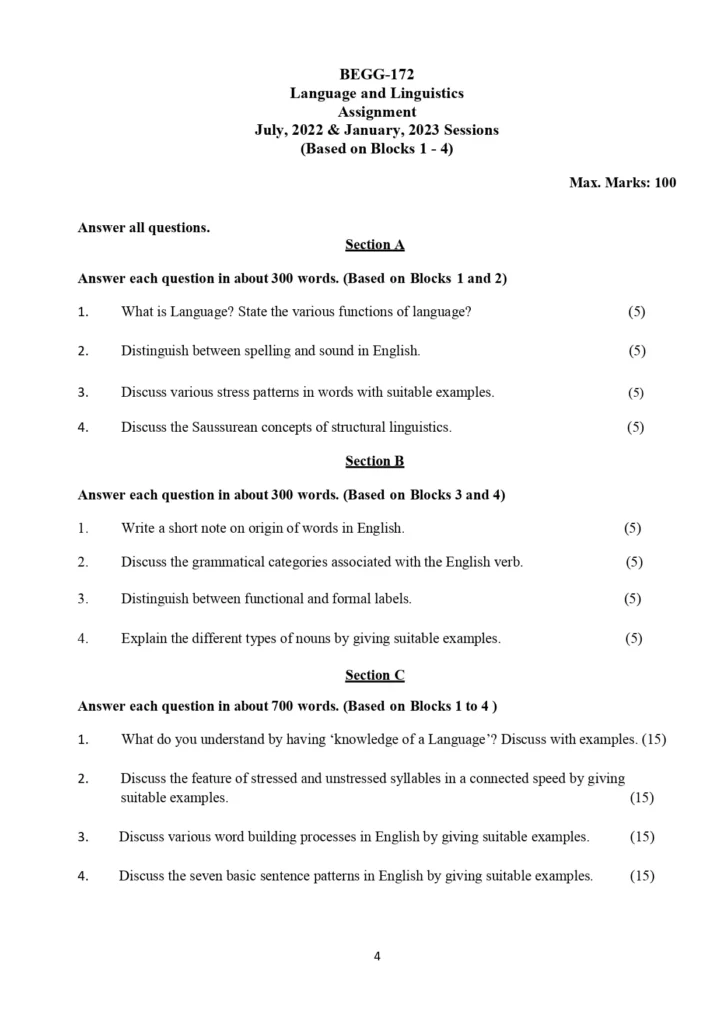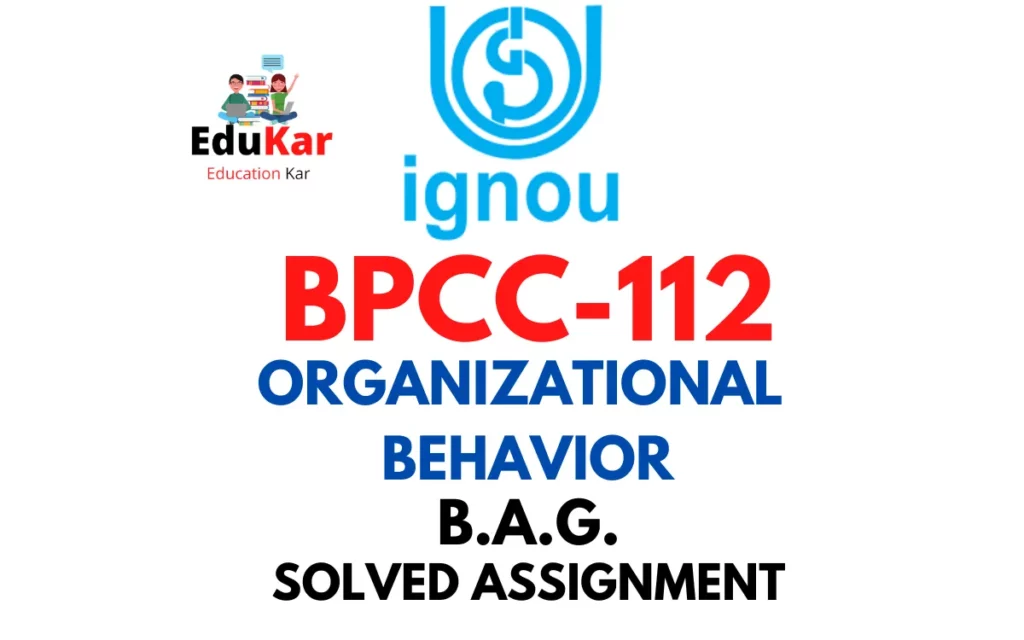Contents
- 1 Section A
- 2 Answer each question in about 300 words. (Based on Blocks 1 and 2)
- 3 1. What is Language? State the various functions of language?
- 4 2. Distinguish between spelling and sound in English.
- 5 3. Discuss various stress patterns in words with suitable examples.
- 6 4. Discuss the Saussurean concepts of structural linguistics.
- 7 Section B
- 8 Answer each question in about 300 words. (Based on Blocks 3 and 4)
- 9 5. Write a short note on origin of words in English.
- 10 6. Discuss the grammatical categories associated with the English verb.
- 11 7. Distinguish between functional and formal labels.
- 12 8. Explain the different types of nouns by giving suitable examples.
- 13 Section C
- 14 Answer each question in about 700 words. (Based on Blocks 1 to 4 )
- 15 9. What do you understand by having ‘knowledge of a Language’? Discuss with examples.
- 16 10. Discuss the feature of stressed and unstressed syllables in a connected speed by giving suitable examples.
- 17 11. Discuss various word building processes in English by giving suitable examples.
- 18 12. Discuss the seven basic sentence patterns in English by giving suitable examples.
- 19

| Title | IGNOU: BEGG-172 Solved Assignment 2022-2023 (Language and Linguistics) |
| University | IGNOU |
| Degree | Bachelor Degree Programme |
| Course Code | BEGG-172 |
| Course Name | Language and Linguistics |
| Programme Name | Bachelor of Arts (General) |
| Programme Code | BAG |
| Total Marks | 100 |
| Year | 2022-2023 |
| Language | English |
| Assignment Code | BEGG-172/July 2022-Jan.23 |
| Last Date for Submission of Assignment: | For June Examination: 31st March For December Examination: 30th September |

Section A
Answer each question in about 300 words. (Based on Blocks 1 and 2)
1. What is Language? State the various functions of language?
Ans: Language is a system of communication used by humans to convey ideas, emotions, and information through the use of sounds, symbols, and gestures. It is a complex and sophisticated tool that allows individuals to express themselves and understand others. There are thousands of different languages spoken worldwide, each with its own unique grammatical rules, vocabulary, and pronunciation.
The main functions of language are to inform, persuade, and express emotions. Informing refers to the use of language to convey information and knowledge, such as in news reports, textbooks, and instructions. Persuasion involves using language to influence others’ opinions and decisions, as in advertisements and political speeches. Expressing emotions refers to the use of language to convey feelings, such as in conversation, poetry, and songs.
Language also serves a social function, allowing individuals to establish relationships and form communities. Through language, people are able to exchange thoughts, experiences, and beliefs with others, and build shared understandings.
Additionally, language is a tool for creative expression and cultural preservation. Poets, writers, and artists use language to create works of art, while communities use language to pass on traditions, beliefs, and cultural practices to future generations.
2. Distinguish between spelling and sound in English.
Ans: English is a complex language with a rich history, and its spelling and sound are two important aspects that are often the source of confusion for learners. Spelling refers to the way words are written using letters, while sound refers to the way words are pronounced.
Spelling in English can be challenging due to its complex history and the influence of several languages. English spelling was originally based on the pronunciation of words, but as the language evolved and was influenced by other languages, the spelling of many words changed, leading to inconsistent spelling patterns. This means that many English words have different spellings that can be pronounced the same way, such as “knight” and “night,” or pronounced differently but spelled the same way, such as “read” and “read.”
In contrast, the sound of English words is much more consistent. English uses a phonetic alphabet, where each letter is associated with a specific sound, making it easier to predict the pronunciation of a word. However, this does not mean that pronunciation is always predictable, as there are exceptions and variations that can cause confusion, such as silent letters, irregular pronunciations, and regional accents.
To summarize, the distinction between spelling and sound in English is important because they are two distinct aspects of the language that can be confusing for learners. Spelling refers to the way words are written, while sound refers to the way they are pronounced. English spelling is complex due to its history, while the sound of English words is more consistent and predictable. Understanding the distinction between spelling and sound can help learners navigate the complexities of the English language and improve their language skills.
3. Discuss various stress patterns in words with suitable examples.
Ans:
Stress patterns refer to the emphasis given to certain syllables in words when speaking or pronouncing them. In English, stress can greatly affect the meaning and clarity of words, and it is an important aspect of pronunciation that can help make spoken English sound more natural and clear.
There are three main stress patterns in English words:
- Primary stress: This refers to the strong emphasis given to the first syllable of a word. For example, “photo-graph,” “humi-dity,” and “present.”
- Secondary stress: This refers to a weaker emphasis given to the second syllable of a word. For example, “photo-grapher,” “humi-dify,” and “presentation.”
- Unstressed: This refers to syllables in words that are not given any emphasis. For example, “be-fore,” “com-pare,” and “ju-niper.”
It is important to note that stress patterns can change the meaning of words. For example, the word “present” can mean a gift, while “pre-sent” can mean to offer or show. In the same way, “pro-duce” refers to making something, while “prod-uce” means to push or urge.
English words can also have multiple stress patterns. Compound words, for example, can have different stress patterns depending on the meaning. For example, “black-board” can refer to a type of writing surface, while “black-board” can refer to a specific type of chalkboard.
4. Discuss the Saussurean concepts of structural linguistics.
Ans: Ferdinand de Saussure was a Swiss linguist and semiotician who is considered to be one of the founding fathers of structural linguistics. He developed several key concepts that have had a lasting impact on the study of language and linguistics.
- Signifier and signified: Saussure introduced the concept of the linguistic sign, which he defined as a relationship between the signifier (the sound or visual representation of a word) and the signified (the concept that the word represents). He argued that the meaning of a word is not inherent in the word itself, but rather in the relationship between the signifier and the signified.
- Language as a system: Saussure saw language as a system of signs, with each word being a part of a larger system of relationships between signs. He emphasized that the meaning of a word is dependent on its relationship to other words in the language and that the meaning of a word can change based on changes in the relationships within the system.
- Synchronic and diachronic perspectives: Saussure distinguished between two perspectives in the study of language: the synchronic perspective, which focuses on the language system at a particular moment in time, and the diachronic perspective, which focuses on the historical development of the language over time.
- Langue and parole: Saussure introduced the distinction between langue and parole, which refers to the distinction between the abstract system of language (langue) and its actual use in speech and writing (parole).
These concepts have had a significant impact on the study of language and linguistics and are still widely used and studied today. The Saussurean approach to language has also influenced other fields, including semiotics, anthropology, and literary theory.
Section B
Answer each question in about 300 words. (Based on Blocks 3 and 4)
5. Write a short note on origin of words in English.
Ans: The English language has a rich and diverse history, with words originating from a variety of sources. The earliest English words were borrowed from Germanic tribes, such as the Angles, Saxons, and Jutes, who invaded Britain in the 5th century. Over time, English has absorbed words from many other languages, including Latin, Greek, French, and Scandinavian languages.
One of the largest contributions to the English vocabulary came from Norman French, which was spoken by the Norman conquerors of England in the 11th century. Many words related to law, government, and the nobility were borrowed from French during this period. In addition, Latin was an important source of technical and scientific vocabulary, and Greek provided many words related to philosophy and science.
In the modern era, English has continued to expand its vocabulary through borrowing and creation of new words. With the rise of globalization and the internet, English has become a global lingua franca and has absorbed words from many other languages, including Spanish, Hindi, Chinese, and Arabic.
In addition to borrowing, the English language also has a long tradition of coinage, or creating new words by combining existing words, modifying them, or giving them a new meaning. This process has resulted in many unique and creative words, such as “cyberspace,” “podcast,” and “blog.”
6. Discuss the grammatical categories associated with the English verb.
Ans: The English verb is a crucial part of the sentence and is associated with several grammatical categories. These categories help to specify the tense, aspect, mood, and voice of the verb, as well as to indicate the number and person of the subject.
- Tense: Tense is a grammatical category that indicates the time when the action of the verb takes place. In English, there are three main tenses: present, past, and future. The present tense indicates actions taking place in the present, the past tense indicates actions that have already taken place, and the future tense indicates actions that will take place in the future.
- Aspect: Aspect is a grammatical category that indicates the nature of the action described by the verb. In English, there are two main aspects: simple and progressive. The simple aspect is used to describe actions that are completed or ongoing, while the progressive aspect is used to describe actions that are currently in progress.
- Mood: Mood is a grammatical category that indicates the attitude or purpose of the speaker towards the action described by the verb. In English, there are three main moods: indicative, imperative, and subjunctive. The indicative mood is used to make statements or ask questions, the imperative mood is used to give commands, and the subjunctive mood is used to express doubt, wish, or hypothetical scenarios.
- Voice: Voice is a grammatical category that indicates the relationship between the subject and the action described by the verb. In English, there are two voices: active and passive. The active voice is used to describe actions performed by the subject, while the passive voice is used to describe actions performed on the subject.
- Number: Number is a grammatical category that indicates the quantity of the subject. In English, there are two numbers: singular and plural. The singular number is used for one person or thing, while the plural number is used for more than one person or thing.
- Person: Person is a grammatical category that indicates the relationship between the subject and the speaker. In English, there are three persons: first, second, and third. The first person is used to refer to the speaker, the second person is used to refer to the person being addressed, and the third person is used to refer to someone or something other than the speaker and the person being addressed.
7. Distinguish between functional and formal labels.
Ans: Functional and formal labels are two types of linguistic labels that are used to describe language and its structures.
- Functional labels: Functional labels describe the purpose or function of a linguistic unit, such as a sentence, clause, or word. These labels are often based on the communicative context in which the unit is used. For example, functional labels might describe a sentence as a statement, question, command, or exclamation. They reflect the way language is used in real-life situations, rather than its formal grammar.
- Formal labels: Formal labels describe the structure and form of a linguistic unit. They are based on formal grammar rules and are used to describe the relationships between words, clauses, and sentences. For example, formal labels might describe the grammatical role of a word (such as subject or object), the type of clause it is (such as independent or dependent), or the type of sentence (such as simple, compound, or complex).
The distinction between functional and formal labels is important because it reflects the two different ways of looking at language: the way it is used in communication and the way it is structured according to grammatical rules. In practical terms, functional labels are often used in linguistics and education to help students understand how language is used in real-life situations, while formal labels are used in grammar books and linguistic research to describe the underlying structure of language.
8. Explain the different types of nouns by giving suitable examples.
Ans: Nouns are a key part of language, and they come in different forms to represent a wide range of people, places, things, and abstract concepts. Here are some of the main types of nouns, along with examples of each:
- Common nouns: Common nouns are general names for people, places, things, and concepts. Examples include “teacher,” “city,” “book,” and “freedom.”
- Proper nouns: Proper nouns are specific names for particular people, places, and things. They are always capitalized. Examples include “John,” “Paris,” and “Mount Everest.”
- Concrete nouns: Concrete nouns refer to tangible, physical things that can be seen, touched, or experienced. Examples include “chair,” “ocean,” and “apple.”
- Abstract nouns: Abstract nouns refer to intangible concepts or ideas that cannot be seen, touched, or experienced. Examples include “love,” “justice,” and “imagination.”
- Collective nouns: Collective nouns refer to groups of people, animals, or things. Examples include “team,” “flock,” and “bunch.”
- Countable nouns: Countable nouns are nouns that can be counted and have both singular and plural forms. Examples include “book,” “cat,” and “child.”
- Uncountable nouns: Uncountable nouns are nouns that cannot be counted and have no plural form. Examples include “water,” “sand,” and “music.”
- Compound nouns: Compound nouns are nouns made up of two or more words that function as a single unit. Examples include “toothbrush,” “firefighter,” and “airplane.”
- Gerunds: Gerunds are nouns formed from verbs by adding “-ing.” They function as nouns and can be used in the same ways as other nouns. Examples include “swimming,” “running,” and “singing.”
Section C
Answer each question in about 700 words. (Based on Blocks 1 to 4 )
9. What do you understand by having ‘knowledge of a Language’? Discuss with examples.
Ans: Language is a system of communication that involves the use of symbols, sounds, and gestures to convey meaning. The knowledge of a language is a complex and multifaceted construct that encompasses a range of linguistic and communicative abilities. In this article, we will explore what is meant by having knowledge of a language and the different aspects that make up this knowledge.
- Phonology: Phonology refers to the sounds of a language and the rules for combining them to form words. Knowledge of phonology includes an understanding of the sound system of a language, including the individual sounds, their distribution, and the way they are combined to form words. For example, a native English speaker has knowledge of the English sound system, including the different vowel and consonant sounds, the way they are pronounced, and the way they combine to form words.
- Morphology: Morphology refers to the structure of words and the rules for combining individual units to form words. Knowledge of morphology includes an understanding of the basic building blocks of words, such as prefixes, suffixes, and inflections, and how they can be used to change the meaning of words. For example, a native English speaker has knowledge of how to use the suffix “-s” to indicate plural forms of nouns, or the suffix “-ing” to indicate continuous action.
- Syntax: Syntax refers to the rules for combining words to form sentences. Knowledge of syntax includes an understanding of the basic structure of sentences, including the use of subject-verb agreement, word order, and punctuation. For example, a native English speaker has knowledge of how to construct grammatically correct sentences, such as “The cat sits on the mat.”
- Semantics: Semantics refers to the meaning of words and sentences. Knowledge of semantics includes an understanding of how words and sentences are used to convey meaning, and how they relate to the world they describe. For example, a native English speaker has knowledge of how words and sentences can be used to convey information about people, objects, events, and relationships.
- Pragmatics: Pragmatics refers to the use of language in context and the social and cultural rules that govern its use. Knowledge of pragmatics includes an understanding of the way language is used in real-life situations, and the social and cultural norms that govern its use. For example, a native English speaker has knowledge of the way language is used to convey politeness, to show respect, or to express emotions.
- Vocabulary: Vocabulary refers to the set of words and phrases used in a language. Knowledge of vocabulary includes an understanding of the meaning and use of words, and how they can be combined to form sentences. For example, a native English speaker has knowledge of a wide range of words and phrases, including both everyday vocabulary and technical terms.
10. Discuss the feature of stressed and unstressed syllables in a connected speed by giving suitable examples.
Ans: Stressed and unstressed syllables play a crucial role in the rhythm and flow of spoken language. In this article, we will discuss the features of stressed and unstressed syllables in connected speech and provide suitable examples to illustrate the differences between them.
- Stressed syllables: A stressed syllable is a syllable that is pronounced with greater emphasis and is typically longer, louder, and higher in pitch than unstressed syllables. In English, stressed syllables are often used to convey the most important information in a word or sentence. For example, in the word “banana,” the stress is on the second syllable, and in the sentence “She is going to the store,” the stress is on the first syllable of “going” and the second syllable of “store.”
- Unstressed syllables: An unstressed syllable is a syllable that is pronounced with less emphasis and is typically shorter, quieter, and lower in pitch than stressed syllables. In English, unstressed syllables are often used to convey less important information in a word or sentence. For example, in the word “banana,” the first and last syllables are unstressed, and in the sentence “She is going to the store,” the first syllable of “She” and the first syllable of “to” are unstressed.
- Connected speech: Connected speech refers to the way words are pronounced in a natural, fluent manner when spoken in a sentence. In connected speech, unstressed syllables are often pronounced more quickly and slurred than stressed syllables, resulting in a rhythmic pattern that is characteristic of a language. For example, in the sentence “I’m going to the store,” the words “I’m” and “to” are pronounced more quickly and slurred than the words “going” and “store,” resulting in a rhythmic pattern that is characteristic of English.
- Intonation: Intonation refers to the rise and fall of pitch in speech, and it is an important feature of stressed and unstressed syllables in connected speech. Stressed syllables are often pronounced with a rise in pitch, while unstressed syllables are often pronounced with a fall in pitch. For example, in the sentence “Do you want to go to the store?” the stress is on the words “you,” “want,” and “store,” and the pitch rises on these words.
- Word stress: Word stress refers to the pattern of stressed and unstressed syllables in a word. In English, word stress is an important feature of pronunciation, as it can change the meaning of a word. For example, the words “import” and “impart” are pronounced differently, as the stress is on different syllables.
- Sentence stress: Sentence stress refers to the pattern of stressed and unstressed syllables in a sentence. In English, sentence stress is an important feature of pronunciation, as it can convey the meaning and emphasis of a sentence. For example, in the sentence “She is going to the store,” the stress is on the words “going” and “store,” indicating that these words are the most important information in the sentence.
11. Discuss various word building processes in English by giving suitable examples.
Ans: Word building is the process of creating new words from existing words or word elements in a language. English is a rich and complex language, with a large vocabulary and many ways of creating new words. In this article, we will discuss the various word building processes in English and provide suitable examples to illustrate each process.
- Compounding: Compounding is the process of combining two or more existing words to create a new word. Compound words can be written as one word, such as “sunscreen,” or as separate words, such as “ice cream.” For example, “toothbrush” is a compound word formed from “tooth” and “brush.”
- Affixation: Affixation is the process of adding a prefix or suffix to an existing word to create a new word. Prefixes are added to the beginning of a word, such as “un-” in “unhappy,” and suffixes are added to the end of a word, such as “-ly” in “happily.” For example, “childlike” is a word formed from “child” and the suffix “-like.”
- Blending: Blending is the process of combining parts of two or more existing words to create a new word. Blending is often used in slang, informal speech, and advertising. For example, “brunch” is a blend of “breakfast” and “lunch.”
- Backformation: Backformation is the process of creating a new word by removing a suffix from an existing word. Backformation is often used to create new verb forms from existing nouns, such as “to email” from “email.” For example, “edit” is a backformed verb form of “editor.”
- Conversion: Conversion is the process of using a word as a different word class without changing the form of the word. Conversion is often used to create new nouns, verbs, and adjectives from existing words, such as “to run” as a verb and “run” as a noun. For example, “to smile” is a verb and “smile” is a noun.
- Acronyms and Abbreviations: Acronyms and abbreviations are words formed from the first letters of a series of words, such as “NASA” for “National Aeronautics and Space Administration.” Abbreviations are often used in official, scientific, and technical writing, such as “Mr.” for “Mister.”
- Clipping: Clipping is the process of creating a new word by shortening an existing word, such as “fax” from “facsimile.” Clipping is often used in informal speech, advertising, and technology. For example, “gym” is a clipped form of “gymnasium.”
- Neologisms: Neologisms are new words or expressions that have been recently created or adopted into a language. Neologisms are often created to reflect changes in technology, society, and culture, such as “selfie” and “hashtag.”
12. Discuss the seven basic sentence patterns in English by giving suitable examples.
Ans:
The seven basic sentence patterns in English refer to the seven common ways in which English sentences can be constructed. These patterns provide a basic structure for creating sentences in English, and are a fundamental aspect of English grammar. In this article, we will discuss each of the seven basic sentence patterns, provide examples, and explain their use.
- Simple Sentence Pattern: The simple sentence pattern is the most basic and straightforward pattern, consisting of a single independent clause. An independent clause is a complete sentence that contains a subject and a verb and can stand alone as a complete thought. For example, “She sings beautifully.”
- Compound Sentence Pattern: The compound sentence pattern is made up of two or more independent clauses joined by a coordinating conjunction, such as “and,” “or,” or “but.” For example, “She sings beautifully, and he plays the guitar.”
- Complex Sentence Pattern: The complex sentence pattern consists of one independent clause and one or more dependent clauses. A dependent clause cannot stand alone as a complete thought and must be connected to an independent clause to form a complete sentence. For example, “She sings beautifully while he plays the guitar.”
- Compound-Complex Sentence Pattern: The compound-complex sentence pattern is a combination of the compound and complex sentence patterns, consisting of two or more independent clauses and one or more dependent clauses. For example, “She sings beautifully while he plays the guitar, and they both enjoy music.”
- Declarative Sentence Pattern: The declarative sentence pattern makes a statement and ends with a period. For example, “She sings beautifully.”
- Interrogative Sentence Pattern: The interrogative sentence pattern asks a question and ends with a question mark. For example, “Does she sing beautifully?”
- Imperative Sentence Pattern: The imperative sentence pattern gives a command or makes a request and often begins with an auxiliary verb, such as “Please.” For example, “Please sing beautifully.”
It is important to note that these seven basic sentence patterns are not absolute and there can be overlap and variations in sentence construction. However, these patterns provide a basic structure for creating sentences in English and are a helpful starting point for understanding English grammar. Understanding the different sentence patterns can also help in writing clear and effective sentences, as well as improving overall communication skills.
How to Download BPAS 186-STRESS AND TIME MANAGEMENT Solved Assignment?
You can download it from the www.edukar.in, they have a big database for all the IGNOU solved assignments.
Is the BPAS 186-STRESS AND TIME MANAGEMENT Solved Assignment Free?
Yes this is absolutely free to download the solved assignment from www.edukar.in
What is the last submission date for (IGNOU-BAG) Solved Assignment?
For June Examination: 31st March, For December Examination: 30th September

![[Solved Assignment] BPCS 185-DEVELOPING EMOTIONAL COMPETENCE (IGNOU-BAG) 2022-2023 [Solved Assignment] BPCS 185-DEVELOPING EMOTIONAL COMPETENCE (IGNOU-BAG) 2022-2023](https://edukar.org/wp-content/plugins/contextual-related-posts/default.png)












